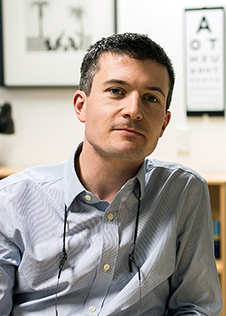When it comes to reducing the country's carbon emissions, most of us will be looking to the energy and transport sectors, or to agriculture.

Dr Jesse Gale.
But Dr Jesse Gale, a Senior Clinical Lecturer at the University of Otago, Wellington, says reducing the carbon emissions of our most commonly-performed surgical procedure could also aid in the fight against climate change.
The health care sector contributes around five per cent of total greenhouse gas emissions in New Zealand, more than those from aviation.
Dr Gale says there are significant opportunities to reduce the carbon emissions produced by the more than 30,000 cataract operations performed each year in New Zealand.
Dr Gale and colleagues, including medical student Matt Latta, calculated the emissions from 142 cataract operations performed in the Wellington region over a three-month period, and found an average of 152 kilograms of carbon dioxide equivalent (CO2e) emitted per case. This is similar to the emissions produced by a one-hour flight (one economy seat) or 62 litres of petrol. This suggests cataract surgery alone produces 4,500 tonnes of CO2e a year, requiring 134 hectares of forest to absorb.
Dr Gale says most of the emissions were from disposable surgical supplies, including gauze, dressings, gowns, gloves, tubing and medications. The second greatest contribution was from patients and staff driving to the hospitals.
“Each operation produces a full rubbish bag weighing 1.3kg on average. The problem is the consumption of such large quantities of disposable single-use supplies. While reducing waste is important, reducing consumption has the most impact on emissions.”
Dr Gale says carbon emissions from cataract surgery vary widely between countries. The Wellington estimate is similar to an estimate in Cardiff, UK, but the estimated footprint in southern India is only six kilograms of CO2e.
“In India their surgical systems save a lot of money and save a lot of carbon emissions while maintaining equivalent safety and quality of outcomes compared to nations like the USA and New Zealand. In India they are reusing most of their surgical equipment and sterile packaging, they have very quick and efficient throughput, and they recycle much of their waste.
“It seems clear that the Indian systems are cheaper and better for the environment, while similar in quality. We need to reflect on the complex barriers that prevent New Zealand surgeons practising like Indian surgeons.”
Dr Gale says the purchasing of surgical supplies and equipment is the area which offers the greatest opportunities for reducing carbon emissions.
“There is a strong appetite among surgeons for hospitals to move to more sustainable and less wasteful surgical practices. A recent survey in the USA found many of the re-use and recycling practices of India would be acceptable to surgeons, if quality and safety were maintained.”
With New Zealand's public sector expected to become carbon neutral, hospitals will need to begin auditing their emissions and making steps towards reducing them, including purchasing low-emission services and supplies, he says.
“Pharmac's upcoming role in bulk purchasing of surgical supplies represents a major opportunity to both improve the measurement of emissions related to procurement and to leverage reductions in emissions during negotiations with suppliers.”
Publication details:
The research paper, “The carbon footprint of cataract surgery in Wellington” is published in the New Zealand Medical Journal.
For further information, contact:
Dr Jesse Gale
Senior Clinical Lecturer
Department of Surgery and Anaesthesia
University of Otago, Wellington
Email jesse.gale@gmail.com
Cheryl Norrie
Communications Adviser
University of Otago, Wellington
Mob +64 21 249 6787
Email cheryl.norrie@otago.ac.nz
Find an Otago expert
Use our Media Expertise Database to find an Otago researcher for media comment.
